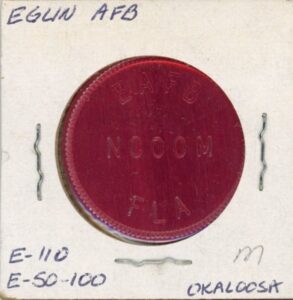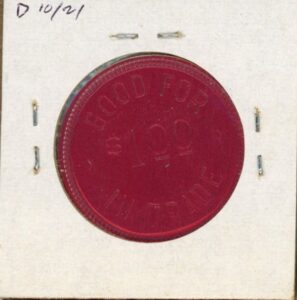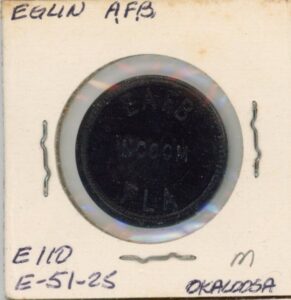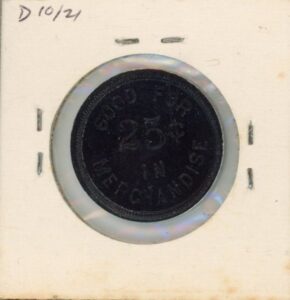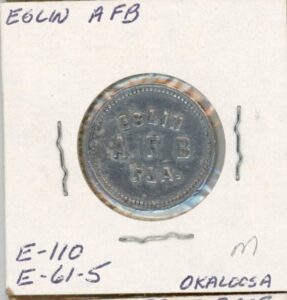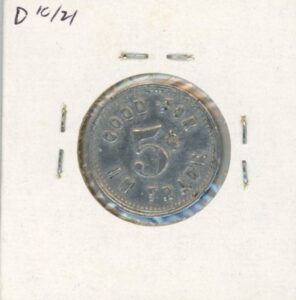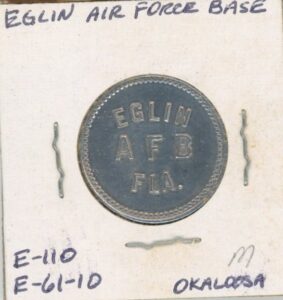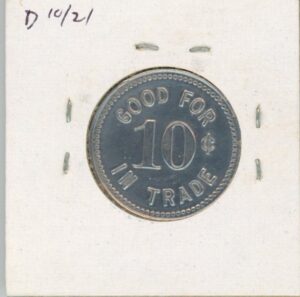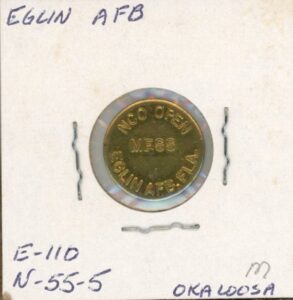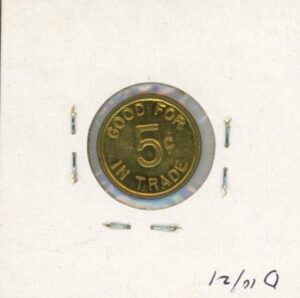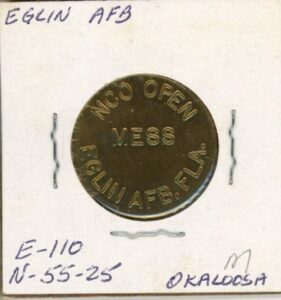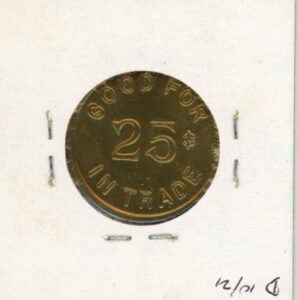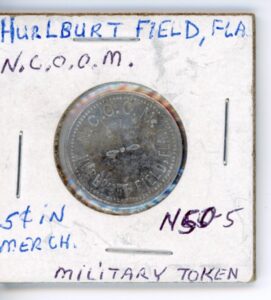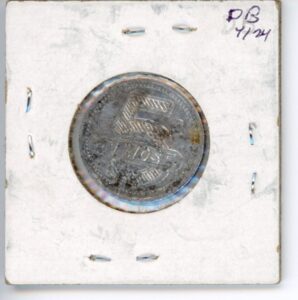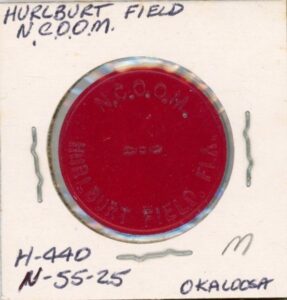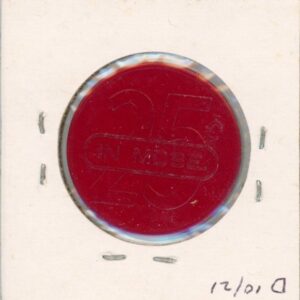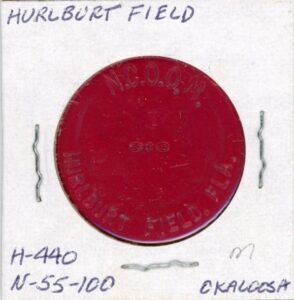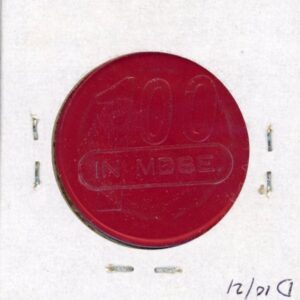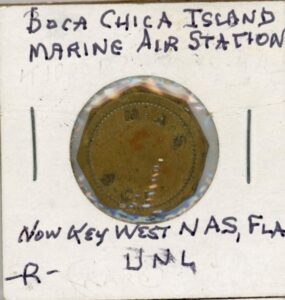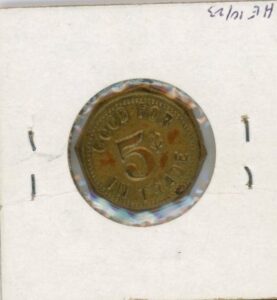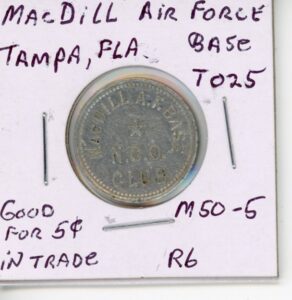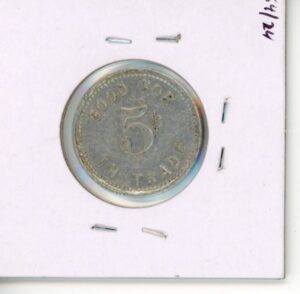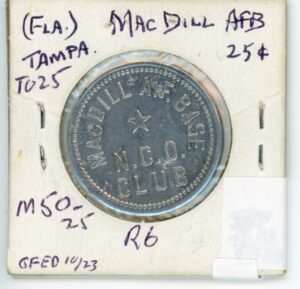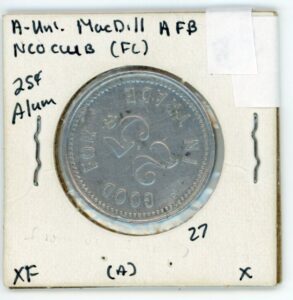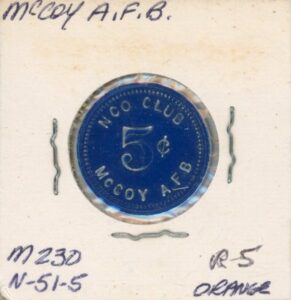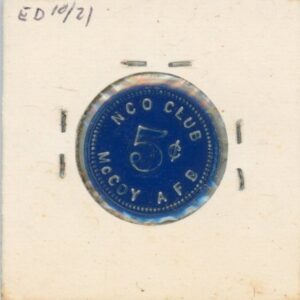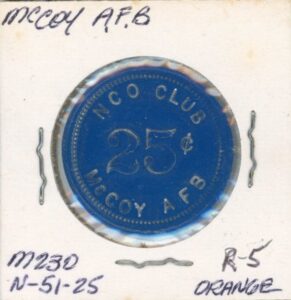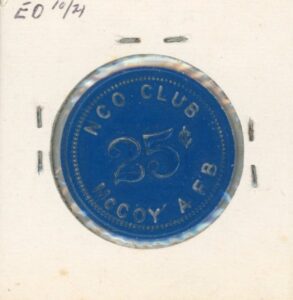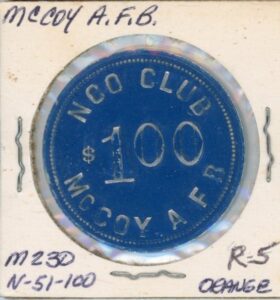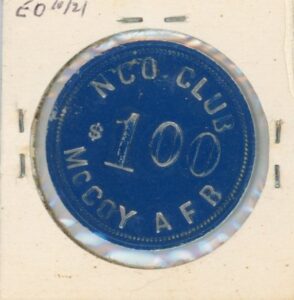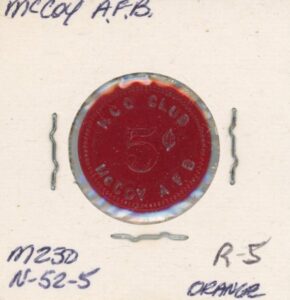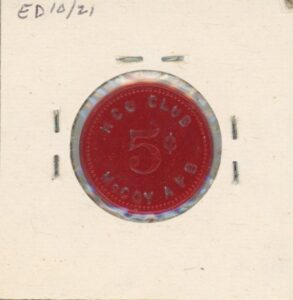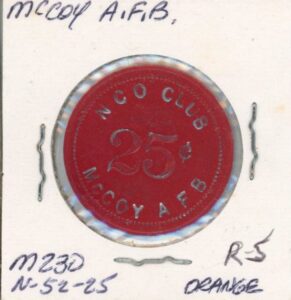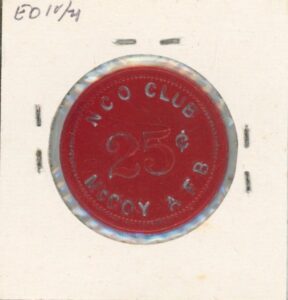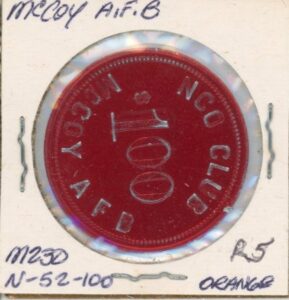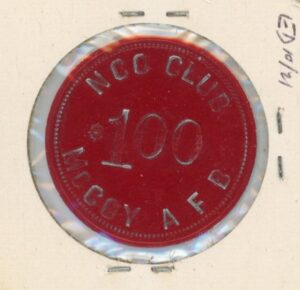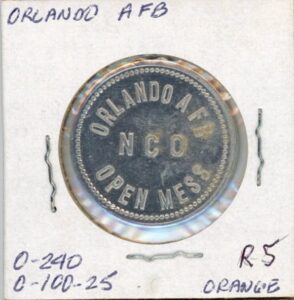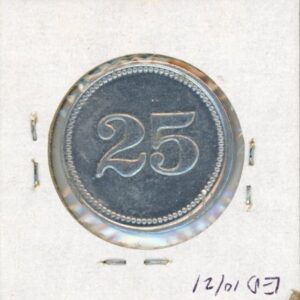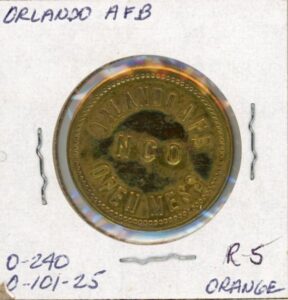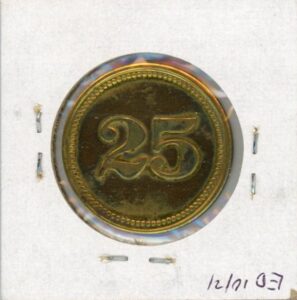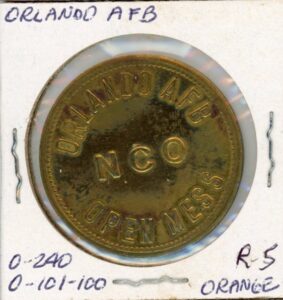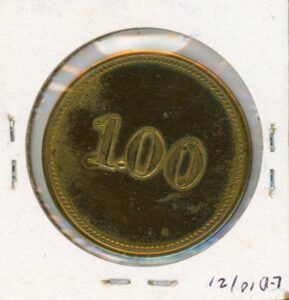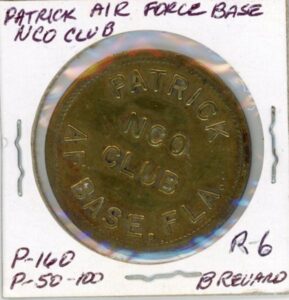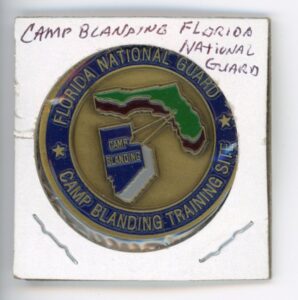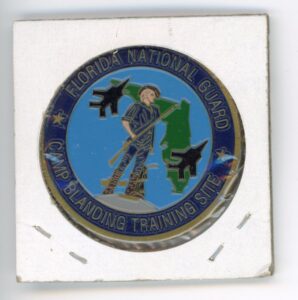Tokens, Military
History
In 1935 when the base initially opened, the name of the facility was the Valparaiso Bombing and Gunnery Base. It was designated as an Air Corps training center until 1942 when it became an Army Air Corp proving ground and munitions center. After World War II when the Air Force became a separate branch of service, the base was renamed Eglin AFB. The base was a pioneer in missile development. The base was assigned the duty of launch testing, handling and developing of missiles because of the Cold War. Eglin became the site of major missile development and testing on a new type of field that was highly instrumented. Over the course of several years, the base has designed and developed ten separate fields for testing, flights, or training maneuvers. All of the fields are still being used today. Most can be found outside the boundaries of the base and all have been named for war heroes.
Fort Barrancas (1839) or Fort San Carlos de Barrancas (from 1787) is a United States military fort and National Historic Landmark in the former Warrington area of Pensacola, Florida, located physically within Naval Air Station Pensacola, which was developed later around it.
The hill-top fort, connected to a sea-level water battery, overlooks Pensacola Bay. From 1839–1844, the historic Spanish fort on the hill was reconstructed and dramatically expanded in brick. This is now termed ‘Fort Barrancas. The older, water battery downhill (Baterie de San Antonio, 1787) has been separately named as Fort San Carlos. It is a remnant from the Spanish fortification, the wooden (Spanish: Fuerte) Fort San Carlos de Barrancas of the late 18th century.
Due to changing requirements, the U.S. Army deactivated Fort Barrancas on April 15, 1947 following World War II. Designated a National Historic Landmark (NHL) in 1960, the fort was transferred to the control and administration of the National Park Service in 1971. After extensive restoration during 1971-1980, Fort Barrancas was opened to the public (see below
The main operation on Mullet Key, however, became Fort De Soto in 1900, named for Spanish explorer Hernando de Soto. The Army post was officially a subpost of Fort Dade, which was constructed on Egmont Key. These posts were to contain batteries of artillery and mortars to protect Tampa Bay from any invading forces. Construction of Fort De Soto began in November 1898 and was completed in 1906. The foundation was constructed of a shell concrete formula and the walls and ceiling used a shell, stone and concrete mix. The main attractions at the completed post were the artillery and mortar batteries, Batteries Laidley and Bigelow. The post consisted of 29 buildings. The post’s features included a large barracks, a hospital, a guardhouse, a blacksmith and carpenter shop, an administration building, and mess hall with kitchen, a bakery, and a storehouse. The site also had brick roads, concrete sidewalks and a narrow-gauge railroad to aid in moving materials and supplies around the post.
Fort Dade (3) (1899-1946) – A U.S. Army Endicott Period coastal defense fort established in 1899 on Egmont Key, Pinellas County Florida. Named in G.O. 43, 4 Apr 1900 for Major Francis L. Dade, 4th U.S. Infantry, who was killed along with his entire command by hostile Seminole Indians 28 Dec 1835. Abandoned in 1923 and put into caretaker status but reactivated during World War II. Permanently abandoned in 1946
Homestead Air Reserve Base is a United States Air Force base located approximately 6 miles (9.7 km) east-northeast of Homestead, Florida.
The host unit at Homestead is the 482d Fighter Wing (482 FW) assigned to the Air Force Reserve Command‘s Tenth Air Force. The 482 FW is a fully combat-ready unit capable of providing F-16C/D multi-purpose fighter aircraft, along with mission ready pilots and support personnel, for short-notice worldwide deployment. The wing has more than 1,500 members, including approximately 1,200 reservists, of which 250 are full-time reservists (Air Reserve Technicians), in addition to 300 full-time civilians.
Homestead ARB was established in 1942 as Homestead Army Airfield (AAF). After a period of dormancy following World War II, the installation began reactivated in 1954 and was redesignated as Homestead Air Force Base in 1955. After its destruction by Hurricane Andrew in August 1992, the base was taken off active status with the Regular Air Force and rebuilt, reopening as an Air Force Reserve facility in 1994. The 482d Fighter Wing is commanded by Colonel Donald R. Lindberg.
Hurlburt Field (ICAO: KHRT, FAA LID: HRT) is a U.S. Air Force installation located in Okaloosa County, Florida, immediately west of the Town of Mary Esther. It is part of the greater Eglin Air Force Base reservation, and is home to Headquarters Air Force Special Operations Command (AFSOC), the 1st Special Operations Wing (1 SOW), the USAF Special Operations School (USAFSOS) and the Air Combat Command‘s (ACC) 505th Command and Control Wing. It was named for First Lieutenant Donald Wilson Hurlburt, who died in a crash at Eglin.
The facility had previously been named the Eglin-Hurlburt Airdrome until 1943; Hurlburt Field, March 1944; Eglin Auxiliary Field No. 9, October 1944; with the current name official on 13 January 1948. The base commander of Eglin Main was also responsible for Hurlburt, 1942–1946, but when the base reactivated on 1 February 1955, it gained a separate commander.
The city of Jacksonville, Florida began to grow in the late 18th century as Cowford, settled by British colonists. Camp Joseph E. Johnston:
Since 1940, Jacksonville has also been a major port for the United States Navy. .Joseph Eggleston Johnston (February 3, 1807 – March 21, 1891) was a career U.S. Army officer, serving with distinction in the Mexican-American War and Seminole Wars, and was also one of the most senior general officers in the Confederate States Army during the American Civil War. After the war, Johnston was an executive in the railroad and insurance businesses. He served a term in Congress and was commissioner of railroads under Grover Cleveland. After the war, Johnston was an executive in the railroad and insurance businesses. He served a term in Congress and was commissioner of railroads under Grover Cleveland. He died of pneumonia after serving in inclement weather as a pallbearer at the funeral of his former adversary, and later friend, William T. Shermandied of pneumonia after serving in inclement weather as a pallbearer at the funeral of his former adversary, and later friend, William T. Sherman
The United States Navy established its presence in Key West in 1832. This was to subvert piracy in the area. Famous pirates, including Blackbeard and Captain William Kidd, were drawn to Key West because of the wealthy shipping merchants based in the warm waters there.
The base grew during the Mexican-American and Spanish-American Wars. During the Spanish-American war, the United States Atlantic Fleet was stationed at Key West.
World War I saw another expansion of the base at Key West. Key West was established as a U.S. Naval submarine base during this war. Its mission was to supply oil to the U.S. fleet, and to prevent German ships from reaching oil supplies in Mexico.
1917 was a big year for NAS Key West. In July, ground was broken for the Trumbo Point Annex, which would become the site for the Marine Corrison Facility. In September of the same year, the first Naval flight departed from Key West. By December, the Naval Air Base Key West was commissioned with LT Parker as first commanding officer.
MacDill Air Force Base, located in South Tampa, was constructed as MacDill Field, a U.S. Army Air Corps, later U.S. Army Air Forces, installation just prior to World War II. With the establishment of the U.S. Air Force as an independent service in September 1947, it became MacDill Air Force Base. During the 1950s and 1960s, it was a Strategic Air Command (SAC) installation for B-47 Stratojetbombers. In the early 1960s, it transitioned to a Tactical Air Command (TAC) installation, briefly operating the F-84 Thunderstreak jet fighter before transitioning to the F-4 Phantom II. During the 1960s, 1970s, and early 1980s, it operated F-4 Phantom II fighters under various fighter wings, followed by F-16 Fighting Falcons in the mid-1980s to early 1990s.
MacDill A.F. Base N.C.O. CLUB / Good For 25c In Trade. M50-25 R6. Rare
Fort McCoy was built during the Seminole Wars. It included brick structures, some evidence of which could still be seen in the 1940s. It may have also been a fort or way station on the King’s Highway. It was also a station on the Ocala Northern Railroad and served as the location for a large sawmill built by E.P. Rentz of the Rentz Lumber Company circa 1910.
Fort Mackay was later renamed Fort McCoy, which is the small town of the same name today. MacKay and MacCoy were both settlers in the area that were killed by Indians during the war. (Yes, the town of Fort McCoy and the settler Jeb MacCoy’s name are spelled different; people just didn’t spell much back then.) When hostilities got really bad, Jeb McCoy was killed by Indians while bringing his family into Fort Russell. Captain Mackay was head of the local militia, and was killed while surveying Itonia Scrub on March 20, 1839.
Naval Training Center Orlando is a former United States Navy training installation located in Orlando, Florida. It was established in 1940 as a Orlando Army Air Base, a World War II training base that was also used for coastal patrols during World War II. Its airfield, the present day Orlando Executive Airport, was returned to the City of Orlando at the end of World War II while the remaining base infrastructure north of Florida Highway 50 was later used as Orlando Air Force Base, a ground technical training and organizational headquarters installation, until it was transferred to the Navy in 1968.
The Naval Air Station Pensacola is said to be the naval aviation cradle. The base is located within the city limits of Pensacola. It is well known for the advanced training fields and programs for the Marine and Navy, as well as coast aviators or naval flight officers. Finally, the base also hosts the Blue Angels, a squadron trained to perform amazing and impressive demonstrations. In other words, it is a very complete base and among the most important ones in the United States. Other than that, the base has the proper equipments to train and teach surgeons and psychologists, but only for naval flight operations. Finally, you can also count a museum, a historic district, a national park and a national cemetery.
St. Francis Barracks is a historic structure constructed of coquina stone located on Marine Street in St. Augustine, Florida named in honor of St. Francis of Assisi. The barracks were constructed between 1724 and 1755 by monks of the Order of St. Francis to replace a series of previous wooden buildings which were destroyed by the ravages of the Florida sub-tropical climate and by fire, both accidental and intentional when the city was razed by the English in 1702.
The barracks were turned into a military structure by the British in 1763 after Florida became a British territory by treaty after the French and Indian War. The Franciscan monks vacated the city along with the majority of the Spanish citizens of St. Augustine.
The name St. Francis Barracks also came to be applied to the military reservation which was developed around the barracks after its conversion for military purposes. Included in this military reservation on the shore of the Matanzas River are several historic structures including The King’s Bakery, believed to be the only extant structure in St. Augustine constructed entirely within the British period of occupation.
Today the St. Francis Barracks serves as the Florida State Arsenal, headquarters for the Florida National Guard as well as the two additional headquarters its subordinate organizations, the Florida Army National Guard and the Florida Air National Guard.
Construction of Tyndall Air Force Base began in May of 1941. It was named Tyndall Field in honor of a local resident, Lt. Frank B. Tyndall, who was killed on active duty in 1930. Tyndall Field was designated as an Army gunnery training center. In December of 1941 the first gunnery students began arriving for training even before construction was completed on Tyndall Field. Thousands of gunnery students passed through Tyndall’s gates to be trained for aerial gunnery position in World War II. One of the most famous students was Clark Gable who trained there in 1943. Just as they do now, foreign NATO forces trained at Tyndall Field in the early years.
Immediately after World War II, Tyndall Field briefly became inactive. That soon changed when the Air Force became a separate branch of the armed services in 1947. Tyndall Field was renamed Tyndall Air Force Base and became an Air Training Command installation which was designated as a pilot instructor school. Tyndall has changed and grown through several commands, but remained at the forefront for pilot training and today finds itself as the home of the Air Forces’ newest aircraft, the F-22 Raptor.
The settlement was originally a 500-acre tract purchased by James William Bryant in 1852 and was known as Mt. Tucker. Prior to the war, there were large orange groves and cotton plantations. In 1860, Welaka’s population was slightly over 100. At the end of the Civil War, fewer than 20 remained. The town grew again and was incorporated on June 21, 1887 and Welaka was affirmed as the town’s name; the name Welaka is said to have been derived from the word local American Indians used for the St. Johns River. By the 1880s, Welaka had become a resort town, marketing itself to visitors seeking medicinal cures from the mineral water of the local springs. The Welaka Mineral Water Company was incorporated in 1907.
Patrick Air Force Base is a United States Air Force Base located between Satellite Beach and Cocoa Beach, in Brevard County, Florida, United States. It was named in honor of Major General Mason Patrick. An Air Force Space Command (AFSPC) base, it is home to the 45th Space Wing (45 SW). In addition to its “host wing” responsibilities at Patrick AFB, the 45 SW controls and operates Cape Canaveral Air Force Station (CCAFS) and the Eastern Range. It was originally opened and operated from 1940 and 1947 as Naval Air Station Banana River, a U.S. Navy airfield. It was then deactivated as a naval installation in 1947 and placed in a caretaker status, until it was transferred to the Air Force in late 1948 and turned into Patrick AFB.
In the 1970s, an expansion program began upgrading post facilities and in 1981, the Department of Defense redesignated Camp Blanding as a Class A military installation. The designation qualified the post for use by greater numbers of troops with more diversified training.
In 1983, the 105 mm artillery firing points were used for the first time since World War II. Tank ranges were upgraded and Tank Tables I through VI can be fired. In addition to improved facilities and ranges, a parachute drop zone and an expeditionary airfield consisting of two gravel runways capable of accommodating C-130 Hercules aircraft have expanded Camp Blanding’s training capacity. The U.S. Navy also utilizes an aerial bombing and strafing target in the southern portion of the post. Upgrading of Camp Blanding’s facilities and training areas continues to this day.
History Sources: Wikipedia
Recent Articles
- Browse Videos of Florida’s Historical Towns and Banks
- Florida Currency Museum Open Showcasing The William Youngerman Collection
- State of Florida Civil War Currency
- Recent Acquisitions
- Mr. and Mrs. Youngerman attend the inagural “The Value of Money” exhibit
Notes & Currency
- 18__ Fernandina $3 Obsolete Note
- 1882 $50 Jacksonville Note Charter #3869
- 1902 $10 Punta Gorda Note Charter #10512
- 1882 $5 Palatka Note Charter #3223
- 1902 $5 Key West Note Charter #7942
Random Cities
Copyright © 2014 Hometown CurrencyAll Rights ReservedPrivacy PolicySponsored by: William Youngerman info@hometowncurrency.org
Custom Wordpress Development by 561Media.com





